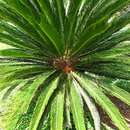en
names in breadcrumbs


Cycas is a genus of cycad, and the only genus in the family Cycadaceae. About 113 species are accepted, which are native to the Asia-Pacific, East Africa and Madagascar.[3] Cycas circinalis, a species endemic to India, was the first cycad species to be described in western literature, and is the type species of the genus. The best-known Cycas species is Cycas revoluta.
The genus is native to the Old World, with the species concentrated around the equatorial regions - eastern and southeastern Asia including the Philippines with 10 species (9 of which are endemic), eastern Africa (including Madagascar), northern Australia, Polynesia, and Micronesia. Australia has 26 species, while the Indo-Chinese area has about 30. India has 9 species. The northernmost species (C. revoluta) is found at 31°N in southern Japan. The southernmost (C. megacarpa) is found at 26°S in southeast Queensland. Due to the occurrence of large number of Cycas species in China, Australia and India, those countries are considered as centres of Cycas diversity.[4]
Cycas is though to have split from all other living cycads at least 200 million years ago, possibly much earlier. Fossil seeds from the Middle Jurassic of England and British Columbia were suggested in a 2017 study to be more closely related to Cycas than other cycads, and were assigned to the same family, Cycadaceae.[5] However, a later study suggested that these seeds could not be assigned to the stem-group of Cycas with confidence due to lacking the double vascular system that characterises the seeds of all living cycads.[6] The earliest fossils assignable to Cycas are known from the Paleogene of East Asia, such as Cycas fushunensis from the Eocene of Northeast China, with East Asia likely representing the ancestral homeland of the genus.[7]
The plants are dioecious, and the family Cycadaceae is unique among the cycads in not forming seed cones on female plants, but rather a group of leaf-like structures called megasporophylls each with seeds on the lower margins, and pollen cones or strobilus on male individuals.
The caudex is cylindrical, surrounded by the persistent petiole bases. Most species form distinct branched or unbranched trunks but in some species the main trunk can be subterranean with the leaf crown appearing to arise directly from the ground. There are two types of leaves - foliage leaves and scaly leaves. The foliage leaves are pinnate (or more rarely bipinnate) and arranged spirally, with thick and hard keratinose. They are not permanent and fall off leaving back leaf-bases. The leaflets are articulated, have midrib but lack secondary veins. The scaly leaves are persistent, brown in colour and protective in function. Megasporophylls are not gathered in cones. Pollination takes place by air.


Cykas take about 10 years to reach sexual maturity, after years of exclusive vegetative growth, which occurs by bulbils arising at the base of the trunk.
Cycas species are threatened worldwide and almost all the species are listed in the IUCN Red List. Cycas beddomei is the only species of the genus Cycas listed in Appendix I of CITES. Cycas rumphii and Cycas pectinata have the most widespread distribution.

Other species:
{{cite journal}}: Cite journal requires |journal= (help) Cycas is a genus of cycad, and the only genus in the family Cycadaceae. About 113 species are accepted, which are native to the Asia-Pacific, East Africa and Madagascar. Cycas circinalis, a species endemic to India, was the first cycad species to be described in western literature, and is the type species of the genus. The best-known Cycas species is Cycas revoluta.